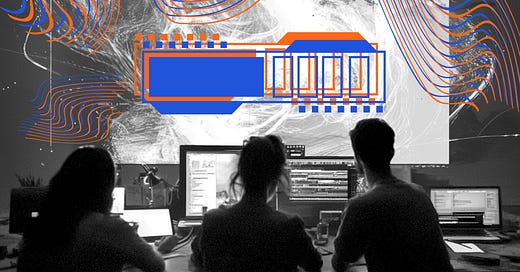You know that feeling when you’re constantly working with a team, collaborating with different people all day long, but still, something feels off? The spark—the truly inspirational, creative energy—is missing.
Most of the time, we’re focused on getting things done, moving projects forward, and juggling multiple constraints. We’re submerged in the organizational sauce, balancing priorities, expectations, and deadlines. But amid all this, real collaboration—the kind that sparks innovation and builds something meaningful together—often gets lost.
You’ve probably read all the beautiful stories about collaboration, about teams coming together to create something groundbreaking. And yes, it does happen. It’s inspiring. It’s powerful. But let’s be honest—it’s also rare.
The times I’ve experienced true collaboration weren’t in the typical work setting. They happened during side projects, workshops, and events. The energy was different. The environment, the goals, the level of engagement—everything was designed for real co-creation. People weren’t just agreeing for the sake of moving forward; they were genuinely building on each other’s ideas.
At work, I started noticing that what we call ‘workshops’ are often just rebranded meetings. People walk in with their own ideas, subtly (or not so subtly) pushing for consensus rather than actually working things out together. It’s less about co-creation and more about aligning to the loudest voice in the room.
So, what does real collaboration look like? It’s when people come in with no rigid assumptions, no pre-scripted agendas—just openness. It’s when ideas don’t belong to individuals but to the collective, and they evolve as they’re passed around, built upon, challenged, and refined.
Mihaly Csikszentmihalyi, in his book Flow, describes how true engagement and creativity emerge when we are fully immersed in a task, balancing challenge and skill. When teams collaborate in a way that fosters this state of flow—where ideas naturally evolve, where contributions are valued, and where people feel both challenged and supported—work becomes more than just a series of tasks. It transforms into something deeply fulfilling and impactful.
This level of collaboration doesn’t just drive better outcomes; it makes work itself more enjoyable and meaningful.
But here’s the tricky part: people in positions of authority often don’t know how to collaborate. They’re used to telling people what to do, and others naturally follow because, well, who wants to disagree with the boss? This kind of structure can move things forward quickly, sure—but does it unlock the full potential of the team? What about all the creativity, insight, and fresh ideas left unexplored?
The urge to collaborate is deeply human. It’s how civilizations have advanced. If people don’t find that space within the workplace, they’ll seek it elsewhere—through side projects, passion pursuits, or communities outside of work. And that’s a shame. Work has the potential to be an incredible playground for building amazing things together, challenging norms, and rethinking the way things are done.
So, the question is: how can we bring real collaboration into our workplaces? How do we create environments where people don’t just comply but co-create?
Because when we get this right, we don’t just move forward—we move forward in ways that truly matter.
Got thoughts, questions, or just want to chat? My DMs are always open—let’s connect!






Having worked across different organizational structures, I've noticed a key distinction in what the author describes. This "missing collaboration" isn't about teamwork failing, but rather about the difference between procedural coordination and genuine co-creation.
What's often overlooked is how power dynamics subtly undermine true collaboration. When I've led interdisciplinary projects, I found that creating structure around idea ownership helps - documenting contributions without attaching names, using anonymous ideation tools, or implementing round-robin techniques where each person must build on someone else's concept.
The issue isn't that people don't want to collaborate, but that organizational systems often incentivize claiming individual credit rather than pursuing collective breakthroughs. The most productive collaborative environments I've experienced weren't necessarily the most enthusiastic ones, but those where criticism was separated from critique, and where the focus remained steadfastly on the evolution of ideas rather than who suggested them.
The topic of collaboration, especially in the workplace, is extremely complex. Here are few cents of mine.
1) HiPPo effect. HiPPO stands for “Highest Paid Person's Opinion.” The HiPPO effect is when the highest paid person's opinion carries more weight than anybody else's in the room. That's because we subconsciously endow highly-paid people with a degree of authority that they don't necessarily deserve.
Been there, seen that and you can do a little about that. But it’s like pushing from no collaboration at all to at least someone hearing your opinion - depending how formidable is the second person. But beware - it costs a lot of emotional energy.
One of the techniques is HiPPo speaking as the last one - works to some degree.
To summarize - yes, leadership counts - no doubts about that.
2) True collaboration spotted repetitive number of times in a workplace. Actually it was a team that I’ve worked in and then I led it. The important characteristic? Everyone was hired from the close network - now, we are all friends, even though are paths starting to diverge a bit.
How to repeat it? I don’t know. Maybe it was about the culture we naturally created - each week joint lunch, honest conversation and commentary what works and what doesn’t, regular hackathons where everyone genuinely enjoyed the work and actually work didn’t feel like a work.